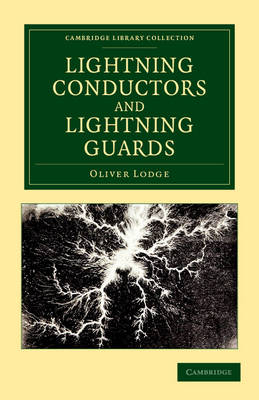
Lightning Conductors and Lightning Guards
Cambridge University Press (Verlag)
978-1-108-05215-3 (ISBN)
As a result of being asked to give public lectures on the subject, the eminent physicist Oliver Lodge (1851–1940) published in 1892 a pioneering study of the protection of buildings, cables and telegraphic instruments from the devastation caused by lightning strikes. This work led him almost immediately to the discovery of electromagnetic wave transmission and ultimately to the development of a version of radio telegraphy. Lodge also saw that many of the current theories about the nature of lightning were seriously in error, and his investigations led to a number of significant changes in the design of lightning conductors and lightning guards. Some of the methods and procedures that Lodge advocated have since become standard practice. They are described with Lodge's characteristic flair and accompanied by a wealth of illustrations that give a fascinating insight into how contemporary scientists and engineers tackled this significant problem.
Preface; 1. General considerations concerning atmospheric electricity and lightning; 2. General considerations regarding damage by lightning; 3. General considerations concerning conductors for house protection; 4. Further details regarding conductors; 5. Experiments establishing the importance of electrical inertia; 6. General explanation of these experiments; 7. Application of the above mode of experimenting top determine further details; 8. Further experiments; 9. Liability of objects to be struck; 10. Experiments bearing on the 'return stroke' and other unexpected vagaries of lightning; 11. Conclusion of the Society of Arts lecture; 12. Previous experiments of Messrs Hughes and Guillemin, and of Rood; 13. On the theory of lightning conductors; 14. Proceedings of the British Association meeting in Bath; 15. Experimental lightning conductors and other observational matters; 16. Summary and repetition of important points; 17. Instructive extracts from reports of damage by lightning; 18. Practical questions; 19. Discussions; 20. Theory of B circuits, of 'alternative path' experiments, and of side-flash; 21. Resistance and impedance for frequencies comparable to a million per second; 22. On the melting of conductors; 23. On conditions under which points can be preferentially struck in Case B; 24. Electric radiation; 25. On the influence of self-conduction on the rate of discharge of a condenser or cloud; 26. Theory and record of the experiment of the alternative path; 27. Other experiments on the discharge of Leyden jars; 28. Lightning conductors from a modern point of view; 29. On lightning guards for telegraphic purposes , and on the protection of cables from lightning; 30. Reply to criticisms; 31. Construction and use of instruments; Appendices; Index.
| Erscheint lt. Verlag | 16.8.2012 |
|---|---|
| Reihe/Serie | Cambridge Library Collection - Technology |
| Zusatzinfo | 18 Plates, black and white; 103 Line drawings, unspecified |
| Verlagsort | Cambridge |
| Sprache | englisch |
| Maße | 140 x 216 mm |
| Gewicht | 740 g |
| Themenwelt | Geschichte ► Teilgebiete der Geschichte ► Technikgeschichte |
| Technik ► Bauwesen | |
| ISBN-10 | 1-108-05215-0 / 1108052150 |
| ISBN-13 | 978-1-108-05215-3 / 9781108052153 |
| Zustand | Neuware |
| Haben Sie eine Frage zum Produkt? |
aus dem Bereich


